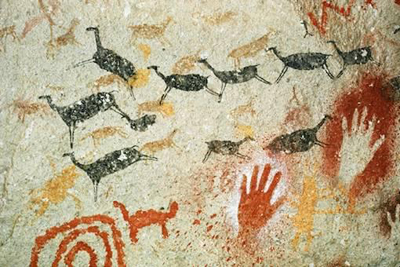2. The intrigue of Palmistry
It fascinates me that so many people today, especially here in the Pacific, like to express their inner selves by inking their skins with tattoos without ever knowing that many of the secrets of their personalities and lives can easily be found on their hands already. Palmistry, better understood as hand analysis since correctly, it is the whole hand that should be examined and not just the palm, is one of the oldest of all forms of fortune telling.
Evidence of man’s fascination with his own hand can be found as far back as early Neolithic times from cave paintings in which human hands have been held against the cave wall and had ochre paint sprayed across it leaving the imprint of the open hand. (The painter would take a mouthful of paint and hold his open hand across the desired spot, then literally spit-spray the paint across the back of his hand, leaving the imprint as a clear outline for all eternity.

Hands painted on the walls of a cave in France’s Ardeche.
Seers of the day, delighted in finding auspicious, esoteric signs on the hands and feet of the newly born Buddha in 563 BCE.

Different Buddha Feet with their varying symbols
There are biblical references to palmistry and the lines of the hand. “He sealeth up the hand of every man, that all men may know his work.” Job 37:7 “Length of days is in her right hand and; and in her left hand riches and honour.” An Arab physician Avicenna wrote a famous volume Canon of Medicine in the eleventh century, which covered material on the significance of the shape and make-up of the hand. This work, once translated into Latin, started the great European interest in palmistry in the twelfth and thirteenth centuries which in turn saw many works on hand analysis written in Europe. Many of these have now disappeared or we have only fragments left. The Digby Roll now in the Bodleian Library and dating from the early fifteenth century is one of the oldest complete manuscripts on the subject. This is a fascinating treatise in the form of a scroll seven feet long and seven inches wide, written by an unidentified scholar; it is thought prior to CE. 1440. The author states what all professional palmists will tell you that: “although it demonstrates the natural tendencies of our conditions, destinies and natural chances…. these must not be treated as irremediable necessities”. Once the printing press was invented however, a veritable plethora of books on the subject began to arrive on the scene.
The appearance of gypsies into Western Europe during the fourteenth and fifteenth centuries coincided with this heightened interest. They were mistrusted initially as the spies by the civic authorites and were refused entry to Paris. The citizenry however, ignoring this and ever eager to fulfil their passion for the new fad, met them outside the city’s walls to have their fortunes told.
Not happy with the attention the gypsies were getting, the Church then claimed they were Satan’s agents and banned their congregations from consulting with them. The gypsies countered by demanding their palms should first be crossed with silver before they read. The Devil it was said, like his latter day brethren, vampires, was afraid of both silver and the sign of the cross; thus the gypsies reasoned, they could not possibly be in league with the dark lord.
Another important book then appeared in the sixteenth century in Germany, John Indagine’s Chiromantia. This was followed in the early nineteenth century by two of the most influential writers ever: Stanislas D’Arpentigny who wrote on the analysis of the hand, its shape and texture etc. but not the lines, and Adolphe Desbarolles who focussed especially on the lines.
In 1900 William G Benham of the USA, published his The Laws of Scientific Hand Reading which amalgamated both Arpentigny’s and Desbarolles’ methods but realised that based on the laws of statistical probability, anyone well versed in the principles could make accurate interpretations of the hands and not require any intuitive input at all. This was the start of a whole different approach to the subject and was to prove groundbreaking.

Palmistry Writer William G Benham
Today, of course, even medical science is interested in investigating the shape and texture of our hands to further our understanding of its implications. The most recent such study (2011) is out of South Korea and concerns the determining of the length of a man’s penis by the ratio of his forefinger and ring finger. And they accuse fortune tellers of being whacky!
http://fingerlengthdigitratio.wordpress.com/category/digit-ratio-research/
Chinese Palmistry
Just like Western style Palmistry, there is a time honoured tradition of analysing the hand in Chinese culture. There are differences of course. With additional or alternative meanings placed on different aspects found on the hand and palm. Perhaps the most significant is that of the weight placed on the right hand for females and left for males. Yang sits left, Yin Right. This is a considerable difference it must be said, especially in light of the fact that in more modern western style palmistry methods, both hands are examined in quite some detail before determining which hand should be taken as the dominant or major hand for the individual. (Correctly done, both hands are examined and referred to in Western Palmistry)

Another significant difference in Chinese palmistry is its recognition by Chinese medicine. Traditional Chinese doctors will make frequent use of their in-depth knowledge of the hand when making diagnoses. In this regard, I think we can say, especially in light of some of the medical research now being done in the correlation between hand analyses and diagnostics that time will show that traditional Chinese medicine’s knowledge of hand analysis has much to teach us yet.
